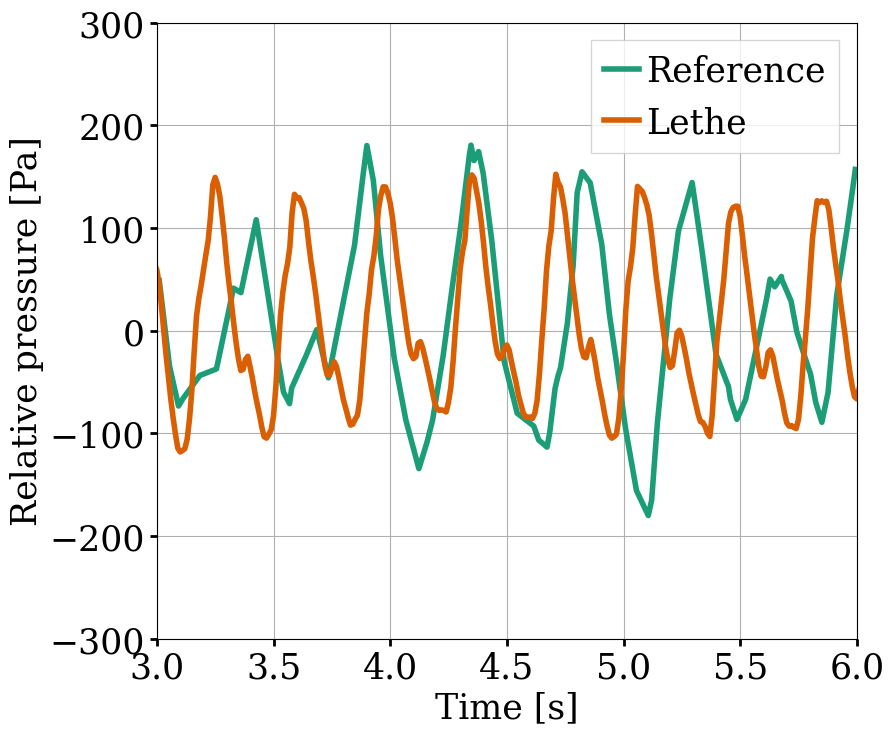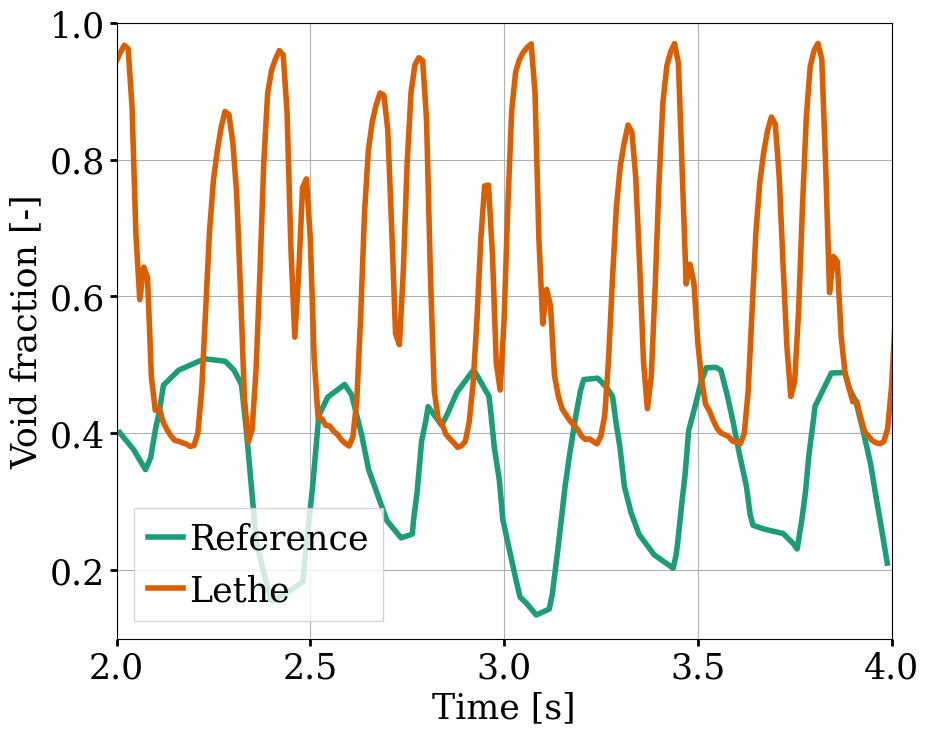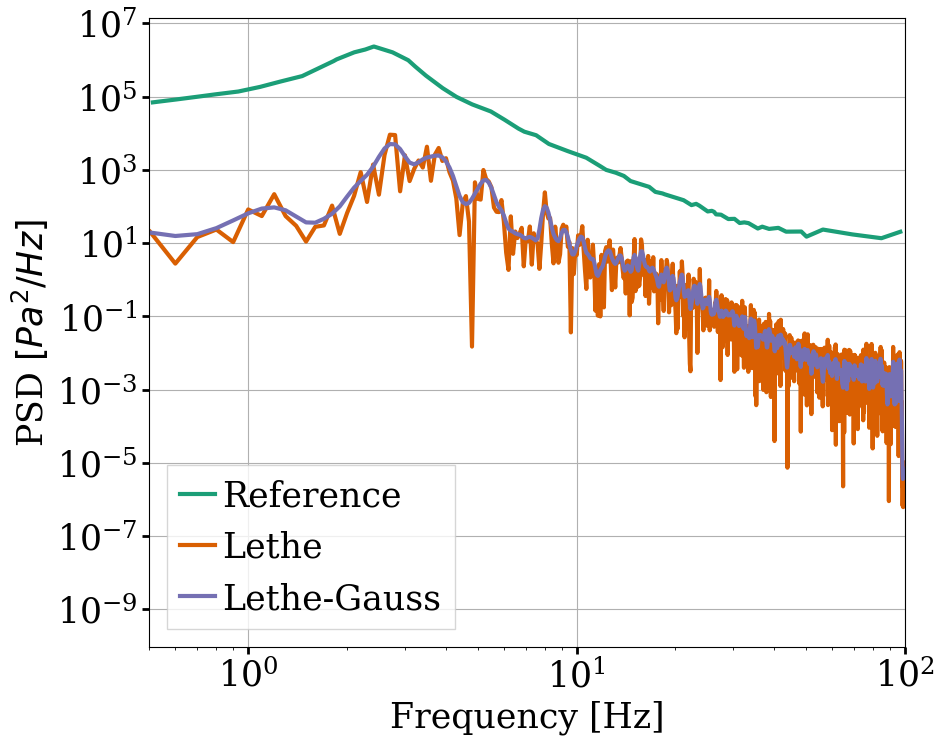Pseudo-2D Gas-Solid Fluidized Bed#
This example simulates the fluidization of a particle bed in gas. It is based on the pseudo-2D experimental setup used by B.G.M. van Wachem et al [1] to validate their two-dimensional fluidized bed simulations.
Features#
Solvers:
lethe-particlesandlethe-fluid-particlesThree-dimensional problem
Gas-solid fluidized bed
Post-processing using Python, PyVista, lethe_pyvista_tools, and ParaView
Files Used in This Example#
All files mentioned below are located in the example’s folder (examples/unresolved-cfd-dem/pseudo-2d-gas-solid-fluidized-bed).
Parameter file for particle insertion and packing:
packing-particles.prmParameter file for CFD-DEM simulation:
gas-solid-fluidized-bed.prmGeometry file:
structure.geoPost-processing Python script:
fluidized-bed-postprocessing.py
Description of the Case#
First, lethe-particles is used to fill the rectangular column with \(17562\) particles, corresponding to the \(39\) g sample of particles used in the experiment. Then, the lethe-fluid-particles solver allows to simulate the fluidization of the particles, with a gas velocity of \(U = 0.9\) m/s at the inlet at the bottom of the column.
DEM Parameter File#
All parameter subsections are described in the parameters guide of the documentation.
We first introduce the different subsections of the parameter file packing-particles.prm.
Mesh#
The domain is generated with GMSH to reproduce the experimental setup. It is a rectangular column with dimensions \(0.09\times0.008\times0.54\) m.
subsection mesh
set type = gmsh
set file name = ./structure.msh
set initial refinement = 1
end
Simulation Control#
A simulation time of \(2.5\) s was chosen, with a time step of \(5\times10^{-6}\). It is important to choose a sufficiently long simulation time so that all particles can become static. The output files generated are stored in the folder output_dem.
subsection simulation control
set time step = 0.000005
set time end = 2.5
set log frequency = 1000
set output frequency = 1000
set output path = ./output_dem/
end
Restart#
The lethe-fluid-particles solver requires reading DEM checkpoint files to start the CFD-DEM simulation. These files are written by enabling the checkpoint option in the restart subsection.
subsection restart
set checkpoint = true
set frequency = 10000
set restart = false
set filename = dem
end
Model Parameters#
subsection model parameters
subsection contact detection
set contact detection method = dynamic
set neighborhood threshold = 1.3
end
subsection load balancing
set load balance method = dynamic
set threshold = 0.5
set dynamic check frequency = 10000
end
set particle particle contact force method = hertz_mindlin_limit_overlap
set particle wall contact force method = nonlinear
set integration method = velocity_verlet
end
Lagrangian Physical Properties#
In this simulation, \(17562\) particles are inserted, with a diameter of \(1.545\) mm and a density of \(1150\;\text{kg}/\text{m}^3\). The Young’s moduli and poisson ratios are kept to reasonable values. For the friction, restitution and rolling friction coefficients, commonly used values are employed, as suggested in the article. We have observed that the results can be quite dependent on the values of the rolling friction coefficient, which was not specified in the reference article.
subsection lagrangian physical properties
set g = 0, 0, -9.81
set number of particle types = 1
subsection particle type 0
set size distribution type = uniform
set diameter = 0.001545
set number of particles = 17562
set density particles = 1150
set young modulus particles = 1e7
set poisson ratio particles = 0.3
set restitution coefficient particles = 0.9
set friction coefficient particles = 0.3
set rolling friction particles = 0.025
end
set young modulus wall = 1e7
set poisson ratio wall = 0.3
set restitution coefficient wall = 0.9
set friction coefficient wall = 0.3
set rolling friction wall = 0.025
end
Insertion Info#
Particles are inserted within a box in the upper part of the column with the volume insertion method. \(4\) steps are required to insert all the particles.
subsection insertion info
set insertion method = volume
set inserted number of particles at each time step = 5000
set insertion frequency = 100000
set insertion box points coordinates = 0.002, 0.002, 0.15 : 0.089, 0.006, 0.48
set insertion distance threshold = 1.5
set insertion maximum offset = 0.5
set insertion prn seed = 19
end
Floating Walls#
To ensure the gas flow is fully developed before reaching the particles, the particle bed needs to be elevated compared to the fluid inlet at the bottom of the column. This is done using a floating wall, with an end time large enough to cover the whole simulation.
subsection floating walls
set number of floating walls = 1
subsection wall 0
set point on wall = 0., 0., 0.
set normal vector = 0., 0., 1.
set start time = 0
set end time = 20
end
end
Running the DEM Simulation#
The packing simulation can be launched on 8 processors with:
Note
Running the packing should take approximately 9 minutes on 8 cores.
After the particles have been packed inside the column, it is now possible to simulate the fluidization of the bed.
CFD-DEM Parameter File#
The CFD-DEM simulation is carried out using the lethe-fluid-particles solver and the packed bed generated in the previous stage. The mesh, lagrangian physical properties, DEM model parameters and floating walls subsections are identical to that of the packing parameter file, so they will not be shown here.
Simulation Control#
The simulation is run for \(12\) s with a time step of \(0.0002\) s. The time scheme chosen for the simulation is a second-order backward difference method (BDF2).
subsection simulation control
set method = bdf2
set output frequency = 100
set time end = 12
set time step = 0.0002
set output path = ./output/
end
Physical Properties#
The kinematic viscosity and density of the gas are set to respectively \(1.33\times10^{-5}\;\text{m}^2/\text{s}\) and \(1.28\;\text{kg}/\text{m}^3\) to match those used in the article.
subsection physical properties
subsection fluid 0
set kinematic viscosity = 1.33e-5
set density = 1.28
end
end
Initial Conditions#
For the initial conditions, we choose zero initial conditions for the velocity.
subsection initial conditions
subsection uvwp
set Function expression = 0; 0; 0; 0
end
end
Boundary Conditions#
For the fluid boundary conditions, the left and right walls (ID = 3) are treated as no-slip boundary conditions, the front and back walls (ID = 2) are defined as slip boundary conditions, the bottom of the column (ID = 0) is an inlet velocity of \(0.9\) m/s and the top of the column (ID = 1) is an outlet for the gas phase. We set the left and the right walls as no-slip boundary conditions to ensure that the gas bubbles is generated in the center of the fluidized bed, as in the experiment.
subsection boundary conditions
set number = 4
subsection bc 0
set id = 0
set type = function
subsection u
set Function expression = 0
end
subsection v
set Function expression = 0
end
subsection w
set Function expression = 0.9
end
end
subsection bc 1
set id = 1
set type = outlet
end
subsection bc 2
set id = 2
set type = slip
end
subsection bc 3
set id = 3
set type = noslip
end
end
Void Fraction#
The void fraction calculation uses the checkpoint files from the previous DEM simulation, with the dem prefix. Then, the Quadrature Centered Method (qcm) is employed to carry out the calculation. We set a very small smoothing coefficient of approximatively \(d_p\) to ensure that the void fraction remains bounded. More information about the different methods used to calculate the void fraction is given in the Lethe documentation (Void fraction section).
subsection void fraction
set mode = qcm
set qcm sphere equal cell volume = true
set read dem = true
set dem file name = dem
set l2 smoothing length = 0.0015
end
CFD-DEM#
We enable all hydrodynamic forces in the CFD-DEM simulation, such as the drag, buoyancy, shear and pressure forces. The drag model used is the Di Felice model, which is a commonly used model for gas-solid flows. We use the default value of the grad-div length scale (grad-div length scale = 1) to ensure that mass conservation is well enforced.
subsection cfd-dem
set grad div = true
set void fraction time derivative = true
set drag force = true
set buoyancy force = true
set shear force = true
set pressure force = true
set drag model = difelice
set coupling frequency = 100
set vans model = modelA
end
Non-linear Solver#
We use the inexact Newton non-linear solver to minimize the number of time the matrix of the system is assembled. This is used to increase the speed of the simulation, since the matrix assembly is computationally expensive.
subsection non-linear solver
subsection fluid dynamics
set solver = inexact_newton
set tolerance = 1e-6
set max iterations = 20
set matrix tolerance = 0.2
set verbosity = verbose
end
end
Linear Solver#
We use an ILU preconditioner with a fill level of one to ensure that the preconditioner is not too expensive to compute, but that the GMRES method converges adequately.
subsection linear solver
subsection fluid dynamics
set method = gmres
set max iters = 200
set relative residual = 1e-3
set minimum residual = 1e-11
set preconditioner = ilu
set ilu preconditioner fill = 1
set ilu preconditioner absolute tolerance = 1e-14
set ilu preconditioner relative tolerance = 1.00
set verbosity = verbose
set max krylov vectors = 200
end
end
Running the CFD-DEM Simulation#
The CFD-DEM simulation is run with the following command:
Note
Running this simulation should take approximately 12 hours on 16 cores.
Post-processing#
A Python post-processing code fluidized-bed-postprocessing.py is provided with this example. It is used to compare, at a height of \(45\) mm in the bed, our simulation results with the experimental results obtained by B.G.M. van Wachem et al [1].
The simulation is compared to the experiment using the pressure, void fraction and bed height fluctuations and the power spectral density of the pressure fluctuations. The power spectral density is calculated using the Fast Fourier Transform (FFT) of the pressure fluctuations with a sampling frequency of \(1000\) Hz, and it is then filtered with a Gaussian filter. The Gaussian filter is used to reduce the noise in the pressure signal, by averaging the values with a Gaussian distribution.
The post-processing code can be run with the following command. The argument is the folder which contains the .prm file.
Important
You need to ensure that lethe_pyvista_tools is working on your machine. Click here for details.
Results#
The following figures compare the pressure, void fraction and bed height fluctuations of the fluidized bed, at \(45\) mm above the floating wall, with the results obtained experimentally by B.G.M. van Wachem et al.



These three figures show that the frequency of the peaks seems to be well replicated for each quantity. However, in the case of the relative pressure and the height of the bed, the amplitude of the signals from the simulation is lower than what was obtained experimentally. Regarding the void fraction, the values are rather far from the experimental ones. This is mainly because the experimental voidage is calculated using light intensity measurements, which can lead to low void fraction values (\(0.2\)). In a packed bed, void fraction is usually higher than \(0.36\).
The following figure compares the simulated pressure power spectral density (PSD) with the one which uses the experimental data.

Although the simulation PSD is several orders of magnitude lower, the shape of the curve and the peak frequency show good agreement with the experimental data.
The simulated fluidized bed is shown in the animation below.